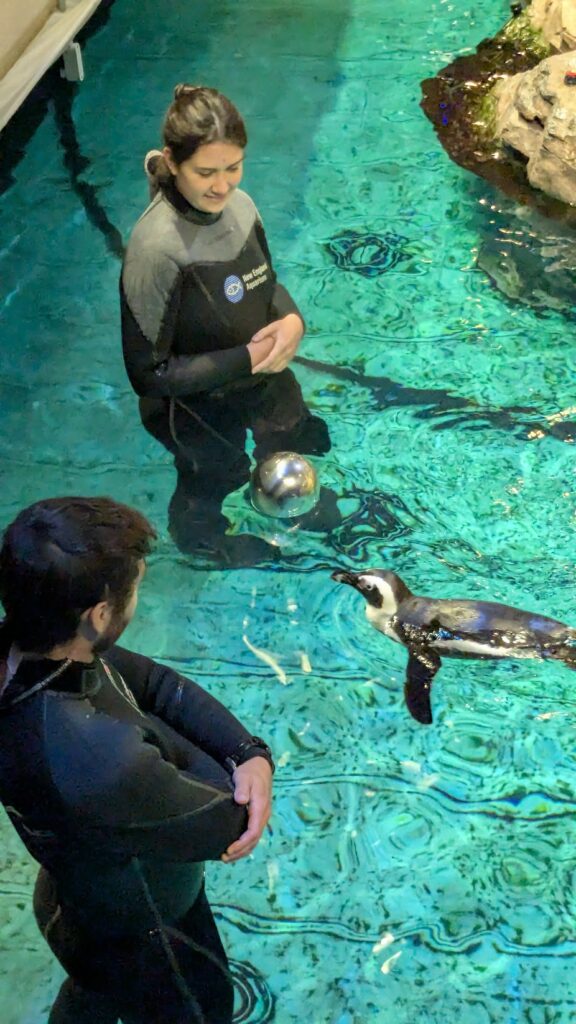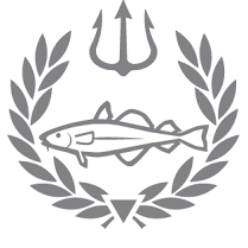On Sunday, I was with another staff member on their birthday, this time with penguin aquarist Mia Luzieti!
Similar to the GOT, the first task of the morning for the Penguin team is food prep. The penguins’ food rotates through several different species of fish, and that day we were feeding them herring, anchovies, and capelin. Ellie, the penguins co-op, and I were in charge of stuffing some of the herring with medication for each of the penguins. Once everything was ready, we suited up for the penguin tray! The water in the penguins exhibit is cold (to mimic the ocean temp in their natural habitat), so our wetsuits were 7mm thick and double-lined. We carefully climbed in the rockhopper exhibit and made our way through the water gates to the African penguin section. Several of the penguins are molting right now, so their feathers were all over the rocks and in the water. Ellie and I used nets to scoop them up and then got ready to help with the morning feed for the African penguins.
Each feeding requires two people: one to do the feeding, and the other to record how many of which fish the different penguins eat. Penguins are self-regulatory feeders, so they will only eat as much as they are hungry for. Recording how much each individual eats can give the trainers insight into their health or their molting season. Mia sat herself on the rocks, and I stood a few feet away observing and tallying the different fish as Mia called out the names of the penguins she fed. The NEAq penguins all wear colored bracelets to tell them apart, but Mia and the penguin trainers all know them by heart. We fed the older African exhibit first, and then moved to the larger and younger group. However, the penguins that are molting can’t come in the water, so we went over and offered them food separately.
 After the feeding it was enrichment time: the trainers had a new enrichment toy, these reflective silver balls. We introduced them to the penguins, and some of them played around a bit with them curiously. After lunch, we hopped back in the tray and I helped with the rockhopper feeding this time. Then we brought out the silver balls again, as well as some colorful plastic ones. We let the penguins play around with them some more as we kept cleaning the exhibit. All the rocks get scrubbed down and disinfected each day, but the floor also gets dirty so my and Ellie’s job was to scrub the rockhopper floor. I got into a real groove after a couple minutes, twisting my foot that I had pinned the doodlebug down with to scrub the floor.
After the feeding it was enrichment time: the trainers had a new enrichment toy, these reflective silver balls. We introduced them to the penguins, and some of them played around a bit with them curiously. After lunch, we hopped back in the tray and I helped with the rockhopper feeding this time. Then we brought out the silver balls again, as well as some colorful plastic ones. We let the penguins play around with them some more as we kept cleaning the exhibit. All the rocks get scrubbed down and disinfected each day, but the floor also gets dirty so my and Ellie’s job was to scrub the rockhopper floor. I got into a real groove after a couple minutes, twisting my foot that I had pinned the doodlebug down with to scrub the floor.
On the way out of the penguin tray, Mia decided to give the Rockhoppers a chance with the balls again. They didn’t seem to know what to do with them, so Mia tried showing them they were for playing by tossing one into the air and catching it again. The Rockhoppers were transfixed and they looked like tennis-goers, bobbing their heads to follow the ball’s movement. It was really funny and we were all cracking up!
The rest of the afternoon I was on observation duty, going around with one of the trainers to check on all the penguins from outside the exhibit, making sure to note any specific behavioral or health concerns. And then, just like that, my day with the penguin team was over.
On Wednesday, I was back with the GOT team. I was proud that I was able to help more independently with food prep in the morning, but I also had the chance to see new aspects of the GOT day and learn more about what they do. After I (with GOT volunteer Alan’s supervision) fed Myrtle, I joined him to see the process for turning on the vacuum: confirming that the divers were all set and ready and then voyaging into the basement to turn the valve on.
While the divers were in for their morning feeding and cleaning dives, I helped the rest of the team with the various chores and tasks on the checklist for the day. Then, in the afternoon I fed Brody the barracuda and did dry support for the divers, taking their empty containers when they were done and giving them the next ones. After that was done, one of the interns (Maddie) and I got a tour of the area behind the scenes of the Temperate Gallery. It was crazy cool to see from the tops of the tanks, and see what was being cared for behind the scenes! The aquarist intern who showed us around told us all about the various personalities of the different fish and species they take care of.
My days at the aquarium just keep getting better! Each one is offering something new, and I am so glad to be able to experience so many varied roles that make NEAq run so smoothly.
– Sofia
